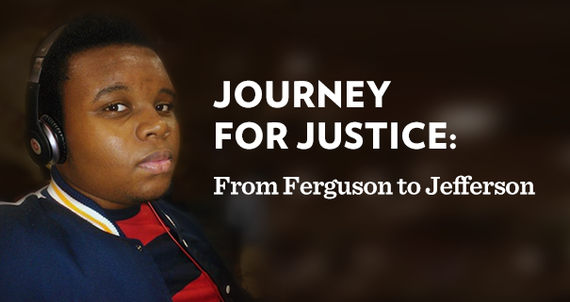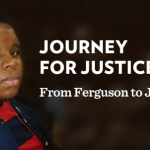
A timeline of the events in Ferguson. I suppose if Ferguson was an isolated context or if Michael Brown’s death was an anomaly, congregations this Sunday might simply pray for the families, for the burning buildings, for the broken glass in the streets and the broken hearts in Ferguson and around the nation. But neither is true. Eric Garner. Marlene Pinnock. Akai Gurley. Trayvon Martin. Emmett Till. The stories attached to these names break our hearts and make us feel the past is pressing into the present. Even when we are not sure that circumstances are motivated by racism, race is “read” into these events due to our …
A timeline of the events in Ferguson.
I suppose if Ferguson was an isolated context or if Michael Brown’s death was an anomaly, congregations this Sunday might simply pray for the families, for the burning buildings, for the broken glass in the streets and the broken hearts in Ferguson and around the nation. But neither is true. Eric Garner. Marlene Pinnock. Akai Gurley. Trayvon Martin. Emmett Till. The stories attached to these names break our hearts and make us feel the past is pressing into the present. Even when we are not sure that circumstances are motivated by racism, race is “read” into these events due to our history.
Racism is in the air — in coffee shops, in classrooms, in conversations in the workplace, and in our congregational life. It breaks my heart.
As we move toward the season of Advent, and consider the circumstances of our nation, I find two texts particularly compelling.
In Luke 4, Jesus proclaims his call to ministry. Jesus came to release those who are captive to poverty, oppression, physical malady and political realities. Jesus’ role as liberator, status quo destroyer, and shackles breaker is ours, because we are the body of Christ.
In Isaiah 58, against a backdrop of national turmoil, the prophet Isaiah reminded the people of God that when we loosen the bonds of injustice, “…You shall be called the repairer of the breach, the restorer of streets to live in.”
Our faith means a call to be liberators. And what we need most to be liberated from — what impinges the souls of Black folk, White folk and all people in these United States — is the tragic legacy of racial prejudice in our nation.
In the only book he ever published, Notes on the State of Virginia (1781), Thomas Jefferson wrote:
I advance it therefore as a suspicion only, that the blacks, whether originally a distinct race, or made distinct by time and circumstances, are inferior to the whites in the endowments both of body and mind.
This suspicion led to pseudoscience and to a lie: white supremacy. Despite the Emancipation Proclamation, despite the Civil Rights Movement and now a Black man in the White House, America is not liberated from the shackles of fear and hatred based on the lie.
When a Black life is cut down, and a grand jury says that a trial is not even needed for the one who did the shooting, it seems justified by the lie.
Being Black in America can feel like suffering a million paper cuts every day, micro-abrasions that build up over time. These wounds and our history are the context for the sorrow pervasive on a day like today. There is the sense that we are devolving rather than progressing. Tragically, this sorrow can turn to anger, and the anger can lead to depression, malaise, and disengagement. It can also lead to violence.
The lie of white supremacy imprisons White people as well; guilt, shame and paralysis can result. Most of us are caught up in this lie. It affects housing patterns and resources for public schools. It affects voting rights and health care. It affects infant mortality and rates of incarceration. Sadly, 11:00 on Sunday morning is still one of the most segregated hours in America, because the lie has our hearts bound in iron.
God’s people are called to be in the business of liberation, and with that work of liberation, our names are changed. We become “repairers of broken places,” and “restorers of streets to live in.” We must take the kind of worship God desires out of our sanctuary doors and into the streets. We can do this with in three ways: with peaceful protesting, with courageous conversations, and with our eyes on the prize of racial reconciliation.
Dr. Martin Luther King, Jr. said,
I refuse to accept the view that mankind is so tragically bound to the starless midnight of racism and war that the bright daybreak of peace and brotherhood can never become a reality… I believe that unarmed truth and unconditional love will have the final word.
I agree with King; our peaceful protesting will bend the moral arc of the universe toward justice. It will take time, commitment and persistence, but I personally find hope in the human capacity to be tenaciously committed to love-in-action.
Peaceful protests might be on the ground in major cities and in Ferguson, but they are also in the virtual community. Watch Twitter and comment. Post on Facebook words of hope and peace. I am personally disappointed that this case will not go to trial. But, as Dr. King says, “We must accept finite disappointment, but never lose infinite hope.” No matter your position on this case, our nation is broken around issues of race. So, with hope as our impetus, we must lose the notion of faith as a spectator sport and engage racial injustice with peaceful protest.
We must engage in courageous conversations. We need to have them in and amongst our own people–our families and our children, our close friends and allies, and in our racial/ethnic groups. A caucus can be an important thing. Make space for the asking of deep questions and the sharing of even awkward sentiments. Why is this happening? What does it mean? How does it affect my soul? Aren’t we past race yet, and can I do anything about this? How does my faith in God relate to these issues? How can I be a healer?
And we must have these conversations across what might seem to be natural divides. We need to have cross-racial/cross ethnic conversations. In order to do this, we must have relationships. We can’t liberate each other while we are in silos. Multiracial/multiethnic congregations like Middle Collegiate Church are critical to the work of racial reconciliation. If your church is diverse, think of ways to encourage deeper relationships. In our context, we have an ongoing small group called Erasing Racism, in which we are having critical conversations about race. If your context is mono-cultural, find a partner with whom to relate. Create a joint worship celebration or prayer vigil during Advent and have conversation as you break bread. Use questions like: When was the first time I was othered due to my personhood? When have I othered someone else? How can these experiences plant seeds for empathy? How did I learn the story of race and what can I do to change it?
Finally, there is something about the very personhood of Jesus the Christ, a person whose ethnic heritage is in itself diverse (see Matthew 1:1-17) and whose very body calls the Body of Christ to be always on the border of difference working for racial reconciliation. This requires engagement, education, and commitment. Be a student of race and culture. Grow your “border personality;” start by reading Toni Morrison’s The Bluest Eye or Tim Wise’s White Like Me, or United by Faith by Curtiss DeYoung, Michael Emerson, George Yancey, and Karen Chai Kim.
As Ferguson smolders from last night’s violence, as a nation processes testimony and tactics, as the case is tried in the media, I am thinking about the lyrics to a song, penned by my friend Tituss Burgess, inspired by the poetry of June Jordan–
You and I are the ones we’ve been waiting for, you and I thought this was somebody else’s war, you and I, are the ones–the ones we’ve been waiting for.
Now is the time, and we are the ones, to release and liberate ourselves from bondage to racism, to repair what is broken in our nation, to restore peace born of justice in the streets.
Bible Study Questions
1. How have I been a releaser or liberator; is there a space in my context for more work in this area?
2. With whom might I partner for courageous conversations on race?
3. What is the call to action these texts speak to my heart?
For Further Reading
The Bluest Eye, Toni Morrison
White Like Me, Tim Wise
United by Faith, Curtiss De Young et al
About ON Scripture
Learn more about the ON Scripture Committee
Like ON Scripture on Facebook
Follow ON Scripture on Twitter @ONScripture
ON Scripture – The Bible is made possible by generous grants from the Lilly Endowment and the Henry Luce Foundation
See more here:
Release. Repair. Restore: Thoughts Beyond Ferguson Toward Racial Healing
































